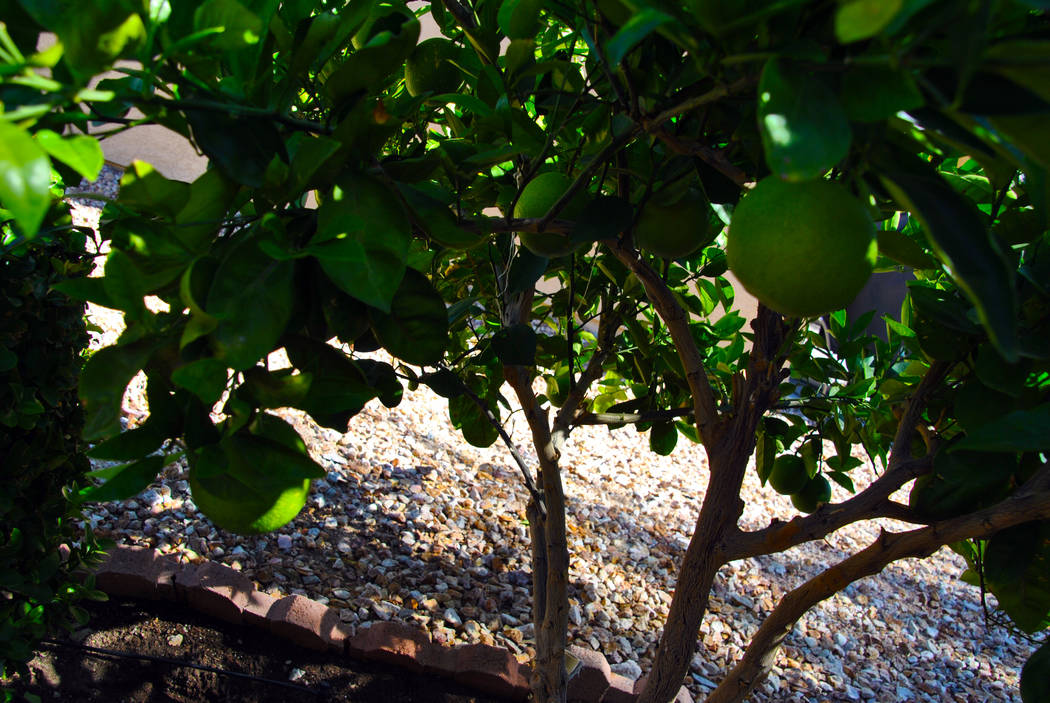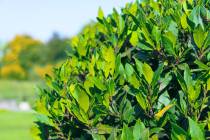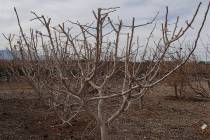Harvest Meyer lemon tree in December or when fruit is sweet
Come and visit me at the Home Improvement and Backyard Expo on Sept. 16-17 from 11 a.m. until 2 p.m. at the South Point. Bring in some plant samples or pictures and let’s talk about them. Would you like a couple of 10-minute classes? I will stay longer than 2 p.m. if anyone wants to chitchat.
Q: When is the proper time to prune Meyer lemon? We have a large crop of lemons ripening now. The tree is very dense and the fruit is on the outside perimeter of the tree. Last time I pruned it in January or February and had no fruit that year. Can I do it now in September or wait until October or November?
A: Meyer lemon, not a true lemon, is usually harvested in December or possibly as late as early January. But do not harvest it later than this. Harvesting time is your signal for pruning. Waiting longer than this can possibly remove fruit during that growing season.
Prune immediately after harvest. Do not delay harvesting the fruit or this can confuse the tree about when to flower again and may affect the quality of the fruit.
It is strange your Meyer lemons are ripening now. Fruit can take nearly 11 months to mature. Harvest the fruit when sugar in the fruit reaches a minimum of 10 Brix. Brix is measured with a refractometer. It’s handier to taste the fruit and see if it’s ready. When it is sweet, harvest it.
Citrus is not pruned much, only to remove crossed or broken branches. You could remove a few limbs too close together, which would allow more light inside the tree canopy. Probably removing three or four limbs would be enough.
Make sure the pruning saw or loppers has been sanitized and sharpened before pruning. Do not leave any stubs unless you want regrowth from them.
Q: I have lots of weeds in my lawn and the more I pull it out, it seems the more comes up. Besides spraying with Roundup, what can I do?
A: The density of a lawn prevents weed problems. Weeds invade your lawn because the lawn is not thick enough to choke out existing weeds and prevent weeds from getting established.
A lack of density can be from too much shade, mowing the lawn too short, disease or insect problems, not applying fertilizer often enough or a lack of water.
Mow at least once a week. Mow tall fescue at a 2-inch height above the soil. Never mow or weed-whack tall fescue below 1½ inches in height. This opens the lawn up for weed invasion.
Bermuda grass lawns need full sunlight. Tall fescue lawns should receive no less than 75 percent of full sunlight. Some people will say 50 percent, but I think that’s right on the edge. If it’s less than 75 percent sunlight, remove or decrease the amount of shade by pruning trees causing this shade.
How do you know the percentage of shade? Look at the ground under the canopy at noon. The amount of shade is easier to estimate during this time of day. If it’s 100 percent shade, open up the canopy with a few pruning cuts that remove entire limbs from the trunk.
Lightly fertilize lawns every four to eight weeks when using quick-release mineral fertilizers. In most bags of inexpensive fertilizer, half the rate listed on the bag is enough to apply if you are using a mulching mower.
Apply quick-release fertilizers to fescue lawns four times a year: during the holidays of Valentine’s Day, Memorial Day, Labor Day and Thanksgiving. Bermuda grass lawns are fertilized during the heat of the summer but ending by Sept. 1 if overseeding.
Slow-release fertilizers are applied in larger amounts but less often. They are expensive but they save labor. Make sure a fertilizer application is applied at Thanksgiving if you want to maintain a green fescue lawn through the winter.
Make sure lawns are irrigated overhead with head-to-head coverage from sprinklers. This means that water from sprinklers is thrown far enough to hit the neighboring sprinkler.
Make sure water pressure to sprinklers is not above or below the range recommended for the nozzles of your sprinklers. Inappropriate water pressures cause poor coverage of the lawn.
Avoid disease problems by irrigating during the early morning hours just before sunrise.
Q: I’ve added some new shrubs under pine trees and they are all doing poorly. I’ve read that pine needles are acidic and can change the pH balance in the soil. I’ve also read that’s not true. Could the pine needles be affecting the new shrubs?
A: I am on the side of “it doesn’t make much difference.” Yes, pine needles contain a lot of resin and they don’t break down easily. But having them on the surface of the soil, or mixed into the soil at about 5 percent of the soil volume, makes no difference at all!
Besides the resin, there is some slight lowering of pH (more acidic), which in our soils is actually helpful. Hopefully, you amended the soil under pine trees with compost at the time of planting.
Digging a hole large enough for plants under pine trees can be difficult because of the roots of the pine. Don’t be afraid to cut pine roots when planting. Allow these cut roots to heal 24 to 48 hours before they are buried in the soil again.
Look closely at the amount of light these plants are receiving. Some plants grow nicely with 50 percent or more sunlight available to them. Others need much more than this for good growth. As an example, Bermuda grass can handle about 10 percent shade, while tall fescue can handle nearly 50 percent shade.
Generally speaking, flowering plants need lots of light compared with nonflowering plants. Signs of a lack of light can be a general failure of the plants to thrive, leaf drop, a general thinning of the canopy and leaf yellowing. You may have to remove some of the lower limbs to allow enough sunlight to the plants growing beneath the canopy.
The pH scale is logarithmic, not linear. A pH of 5.5, a common pH value for acid soils, is 100 times more acidic than our soils with a pH of 7.5. Our soils commonly range from 7.8 to 8.5.
Pine needles decompose more quickly if they are cut or shredded.
Q: I laid tall fescue sod earlier this year in my backyard. It has been great until about a week ago, when half the yard turned yellow. I use an inground sprinkler system and water seven days a week for three minutes at 7 a.m., 11 a.m. and 3 p.m. The soil is moist about 4 inches down.
A: Why are you still watering three times a day for three minutes each time? This might be OK for the first couple of weeks after laying the sod, but those times should change.
Your irrigation schedule during the heat of the summer should be once a day for a total of about 12 to 15 minutes if you are using pop-up sprinklers. The actual number of minutes depends on the precipitation rate and spacing of the sprinklers.
These are determined by the type of nozzle, pressure used and irrigation design. Poorly designed irrigation systems require more minutes than well-designed systems.
The best times to water a lawn are the hours just before sunrise when the wind is calm. If you can’t water for 12 to 15 minutes all at once because of puddling or water runoff, break your irrigation times into smaller increments, each about one hour apart.
Get all of the water the lawn needs for that day into the soil during the early morning hours. The lawn can drink from this reservoir of soil water until the next irrigation.
Aerify the lawn with a core aerator two or three times a year until you can water the lawn for longer and longer periods of time without puddling or runoff. After aerating a few times, you should be able to easily wet the soil to a depth of 8 to 10 inches each time you irrigate.
Bob Morris is a horticulture expert and professor emeritus of the University of Nevada, Las Vegas. Visit his blog at xtremehorticulture.blogspot.com. Send questions to Extremehort@aol.com.



























